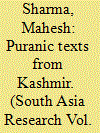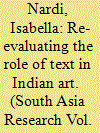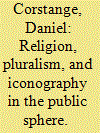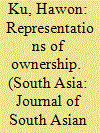|
|
|
Sort Order |
|
|
|
Items / Page
|
|
|
|
|
|
|
| Srl | Item |
| 1 |
ID:
115040


|
|
|
|
|
| Publication |
2012.
|
| Summary/Abstract |
South Africa has experienced two periods of contrasting nation-building, with apartheid's exclusionary ideology of separate development contrasting with the inclusive nationhood discourse of the democratic period. Throughout these periods, the South African government has utilised iconography within the cultural landscape in efforts to promote the changing national narrative to domestic and international audiences. Analysis of postage stamps issued by the South African government during and after apartheid demonstrate the continuing evolution of nationalism and identity. The appropriation of the iconographic power of postage stamps by the ANC, through their production of propaganda postage labels during the 1980s, reinforces the importance of such ephemeral, quotidian objects while complicating national narratives presented in official philatelic issues.
|
|
|
|
|
|
|
|
|
|
|
|
|
|
|
|
| 2 |
ID:
082551


|
|
|
|
|
| Publication |
2008.
|
| Summary/Abstract |
Focusing on the western Himalayan provinces of Kashmir and Himachal Pradesh, this article argues that the Indian hagiographic texts of the Puranas should be understood as a nuanced literature that sought to effect a paradigm shift in liturgy and praxis, fusing polity and religion, largely in contravention to the earlier Vedic-Upanishadic texts and their commentaries, but also building on them. Emphasis on local Sanskrit literature, specifically the Nilamata Purana, which uses popular iconographies of river goddesses, served many centuries ago to reconstruct the geography of the area within the wider context of the subcontinental sacred geography.
Keeping within the Puranic tradition, the article focuses on the rituals and ceremonials associated with rivers, while also charting the process by which regional pilgrim centres were formed on their banks, devising a sacred space parallel to the subcontinental cosmos. This reinforces the logic of the sacred river, the worshipped deity, as a process by which brahmanic dominance was asserted in the peripheral areas of early India, or ideologically and politically contested regions such as Kashmir. In the sacrality of the river Vitasta, Brahmanism as an ideology reasserts itself by restating the tradition in relation to its sacral past, creating a new sacred space and devising a sacred icon to reclaim this particular geography for the devout Brahmanas
|
|
|
|
|
|
|
|
|
|
|
|
|
|
|
|
| 3 |
ID:
091722


|
|
|
|
|
| Publication |
2009.
|
| Summary/Abstract |
This article seeks to rediscover and contemporise the importance of using the shastras, Sanskrit technical treatises, as a standard of critique to analyse Indian art. The applicability and interpretative value of this approach for the study of Indian art history is exemplified by a case study of the miniature paintings representing the image of Shri Nathji in Nathdvara. Analysing the image of Shri Nathji as it appears in Nathdvara miniature paintings from different shastric points of views, including the theories of measurement and proportion, postures, mudras and rasa theory, the article proposes to include in the definition of shastra not only canonical textual sources but also practical/visual and oral/verbal transmitted knowledge. While textual concepts are used as a methodology for the reading of the image of Shri Nathji, the canonical shastric theories are considered side by side with such oral and practical knowledge in an attempt to redefine the concept of 'text' for Indian tradition, and especially to further our knowledge on the relationship between text and image in Indian art.
|
|
|
|
|
|
|
|
|
|
|
|
|
|
|
|
| 4 |
ID:
112512


|
|
|
|
|
| Publication |
2012.
|
| Summary/Abstract |
This article examines mass public discourse on religion and pluralism in diverse societies. It argues that religion enters the public sphere by defining countervailing narratives about sectarianism, which is exclusive and divisive, and ecumenicism, which is inclusive and unifying. Most empirical studies focus on elites as the producers of discourse and ignore the regular people who comprise the "real" public. In contrast to prior work, this article systematically examines mass public discourse, with Lebanon, a religiously diverse developing world society, as its research venue. It uses a novel combination of original survey data and publicly displayed religious and political iconography to study the exchange of ideas about religion and pluralism among the mass public. It shows that sectarian discourse articulates ethnocentric and antiplural statements, whereas ecumenicism, by contrast, mitigates ethnocentrism and valorizes pluralism.
|
|
|
|
|
|
|
|
|
|
|
|
|
|
|
|
| 5 |
ID:
132269


|
|
|
|
|
| Publication |
2014.
|
| Summary/Abstract |
This article explains the changes found in patas (cloth paintings) depicting Shatrunjaya, which were produced for Shvetambara Murtipujak Jains during the nineteenth century in Gujarat. These patas differed from earlier tirtha patas in that they were much larger and depicted Shatrunjaya as the central subject matter. They were also meticulous in depicting the topographical and architectural features of the site, and included Palitana, the adjacent town ruled by the Hindu Thakur. The emergence of the site as a centre for Jain pilgrimage, as well as changes in Jain perceptions of the site, led to these transformations
|
|
|
|
|
|
|
|
|
|
|
|
|
|
|
|
|
|
|
|
|